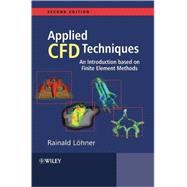
Rainald Lohner, Department of Computational and Data Sciences, 4400 University Drive, Fairfax, Virginia 22030, USA? Rainald Lohner gained his PhD from the University of Wales, Swansea. He is now a director of the Computational Fluid Dynamics Center of the Department of Computational and Data Sciences at George Mason University, Virginia, USA. His research interests include Fluid-Structure Interaction, Unstructured Grid Generation, Pre-Processing, and Parallel Computing.? Notable achievements include a Distinguished Professor award 'for his substantive and innovative contributions to the field of computational fluid dynamics' by GMU and being a made a Honorary Professor of the University of Wales at Swansea.
| Foreword To The Second Edition. | |
| Acknowledgements | |
| Introduction And General Considerations | |
| The CFD code | |
| Porting research codes to an industrial context | |
| Scope of the book | |
| Data Structures And Algorithms | |
| Representation of a grid | |
| Derived data structures for static data | |
| Derived data structures for dynamic data | |
| Sorting and searching | |
| Proximity ins pace | |
| Nearest-neighbours and graphs | |
| Distance to surface | |
| Grid Generation | |
| Description of the domain to be gridded | |
| Variation of element size and shape | |
| Element type | |
| Automatic grid generation methods | |
| Other grid generation methods | |
| The advancing front technique | |
| Delaunay triangulation | |
| Grid improvement | |
| Optimal space-filling tetrahedra | |
| Grids with uniform cores | |
| Volume-to-surface meshing | |
| Navier-Stokes gridding techniques | |
| Filling space with points/arbitrary objects | |
| Applications | |
| Approximation Theory | |
| The basic problem | |
| Choice of trial functions | |
| General properties of shape functions | |
| Weighted residual methods with local functions | |
| Accuracy and effort | |
| Grid estimates | |
| Approximation Of Operators | |
| Taxonomy of methods | |
| The Poisson operator | |
| Recovery of derivatives | |
| Discretization In Time | |
| Explicit schemes | |
| Implicit schemes | |
| Awordof caution | |
| Solution Of Large Systems Of Equations | |
| Direct solvers | |
| Iterative solvers | |
| Multigrid methods | |
| SImple Euler/Navier-Stokes Solvers | |
| Galerkin approximation | |
| Lax-Wendroff (Taylor-Galerkin) | |
| Solving for the consistent mass matrix | |
| Artificial viscosities | |
| Boundary conditions | |
| Viscous fluxes | |
| FLux-Corrected Transport Schemes | |
| The FCT Concept | |
| Algorithmic implementation | |
| Steepening | |
| FCT for Taylor-Galerkin schemes | |
| Iterative limiting | |
| Limiting for systems of equations | |
| Examples | |
| Summary | |
| Edge-Based Compressible Flowsolvers | |
| The Laplacian operator | |
| First derivatives: first form | |
| First derivatives: second form | |
| Edge-based schemes for advection-dominated PDEs | |
| INcompressible Flowsolvers | |
| The advection operator | |
| The divergence operator | |
| Artificial compressibility | |
| Temporal discretization:projection schemes | |
| Temporal discretization: implicit schemes | |
| Temporal discretization of higher order | |
| Acceleration to the steady state | |
| Projective prediction of pressure increments | |
| Examples | |
| Mesh Movement | |
| The ALE frame of reference | |
| Geometric conservation law | |
| Mesh movement algorithms | |
| Region of moving elements | |
| PDE-based distance functions | |
| Penalization of deformed elements | |
| Special movement techniques for RANS grids | |
| Rotating parts/domains | |
| Applications | |
| Interpolation | |
| Basic interpolation algorithm | |
| Fastest 1-timealgorithm:brute force | |
| Fastest N-time algorithm: octree search | |
| Fastest known vicinity algorithm: neighbour-to-neighbour | |
| Fastest grid-to-grid algorithm: advancing-front vicinity | |
| Conservative interpolation | |
| Surface-grid-to-surface-grid interpolation | |
| Particle-grid interpolation | |
| Table of Contents provided by Publisher. All Rights Reserved. |
The New copy of this book will include any supplemental materials advertised. Please check the title of the book to determine if it should include any access cards, study guides, lab manuals, CDs, etc.
The Used, Rental and eBook copies of this book are not guaranteed to include any supplemental materials. Typically, only the book itself is included. This is true even if the title states it includes any access cards, study guides, lab manuals, CDs, etc.